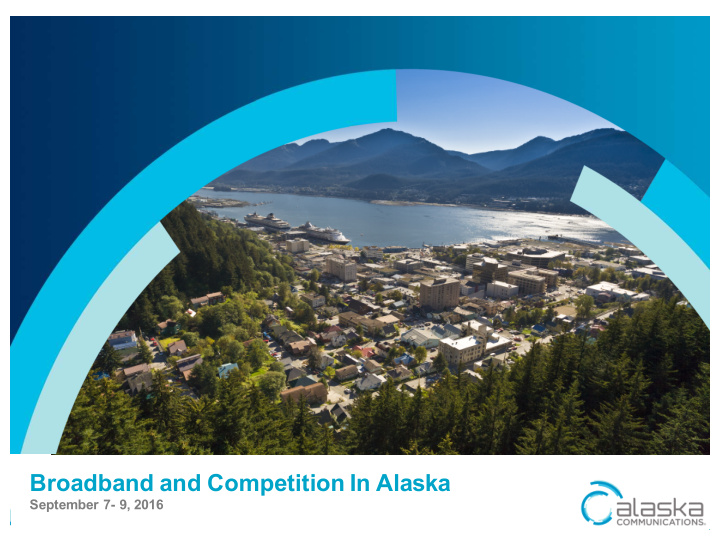



Broadband and Competition In Alaska September 7- 9, 2016 alaskacommunications.com 1 | Alaska Communications
Overview 1. The Commission Should Adopt Final Terms For CAF Phase II In Alaska Now, And Enable Broadband For Thousands of Unserved Alaskans 2. Evidence Submitted On the Record In the BDS Rulemaking Supports Treating Price Cap Service Areas In Alaska As Competitive For the BDS and Special Access Market 3. To the Extent Any Regulation of BDS In Alaska Is Justified, It Is In the Bush, Where Middle-Mile Facilities Are Non-Competitive and Create a Bottleneck To BDS Competition alaskacommunications.com 2 | Alaska Communications
Eligible CAF II Locations In Alaska • The Commission has conceded that Alaska costs and geography are not accurately captured by the model • Alaska Communications proposed in Fall 2014 to serve 100% of unserved locations in eligible CBs (excluding off-road CBs) • Unlike in other price cap areas, in Alaska the Commission desires a specific number of locations to be served • On February 3, 2015, Alaska Communications proposed service to 26,000 unserved locations, based on model version 4.2, the last published version that included AK data • Alaska Communications network engineers have devoted significant time to analyzing locations to begin planning for CAF II deployment, but have NOT been able to identify 26,000 eligible locations within the CBs identified by the Commission as eligible for CAF II funding alaskacommunications.com 3 | Alaska Communications
Flexibility Is Needed To Reach 26,000 Locations • FCC data indicates there are about 31K locations in 1617 eligible CBs in Alaska Communications’ service area • 46 of those CBs are off-road and inaccessible, prohibiting broadband deployment • 339 of those CBs have zero service locations according to ACS records • Removing the above 385 CBs leaves only 1232 eligible CBs • ACS data indicates fewer than 26K available locations in the 1232 eligible CBs • At least 2K and as many as 12K “eligible” locations may already be “served” by ACS, leaving a gap that cannot be filled elsewhere • At most 24K “unserved” locations will be found in eligible CBs – but there may be as few as 14K – thus the need for flexibility • The precise number of “unserved” locations in the “eligible” CBs will be known only after 18-24 months of engineering and field work • Flexibility to serve “unserved” locations in CBs that are partially served or are deemed low-cost but are adjacent to eligible CBs is needed to ensure Alaska Communications can deliver on the expectation of enabling broadband to 26,000 currently unserved locations alaskacommunications.com 4 | Alaska Communications
The BDS Rulemaking and Data Collection Show That Alaska Price Cap Areas Are Competitive • Evidence of downward pricing trends and comparatively low prices in Alaska support the conclusion that BDS is competitive in on-road service areas • Direct evidence of relative market shares also definitively shows that BDS is subject to intense competition in Alaska’s on-road service areas • Locations of BDS service customers and revenues, as well as locations where federal support dollars derived from BDS services are flowing, similarly demonstrate where competition exists in Alaska Communications’ territory • The SADC data for Alaska is deficient, and does not accurately describe the level of competition in the BDS market in the state’s price cap areas • As has been the case in many other proceedings, tools that may be applied nationally with reasonable results are not appropriate in Alaska • The one type of area that lacks effective competition is Bush Alaska -- and that is because bottleneck middle-mile facilities are controlled by an unregulated monopolist alaskacommunications.com 5 | Alaska Communications
The Middle-Mile Deficit Creates A Bottleneck To BDS Competition • In Alaska, the Commission cannot increase BDS competition in the Bush without solving the middle mile problem • To the extent regulation of BDS can be justified, it is only in the Bush (off-road areas not linked to terrestrial fiber) • BDS options for Bush communities are limited by the absence of terrestrial middle-mile connections that are adequate, affordable and available on non- discriminatory terms • GCI controls what limited middle-mile facilities are available, but is not offering them on affordable, non-discriminatory terms • Increasing middle mile availability will bring competition and advanced services to the Bush alaskacommunications.com 6 | Alaska Communications
Summary 1. The Commission should adopt final CAF II terms for Alaska Communications -- The company needs 18-24 months to pinpoint the locations to which it will deploy 10/1 qualifying broadband 2. Alaska Communications cannot be expected to deploy to more locations than are “unserved” in eligible census blocks – The Commission should adopt realistic build-out obligations with appropriate flexibility for the unique conditions in Alaska 3. The Commission should not bring competitive markets under BDS regulation, stifling investment and competition 4. The Commission should address the lack of effective access to middle-mile facilities in Bush Alaska alaskacommunications.com 7 | Alaska Communications
Alaska Communications Communities alaskacommunications.com 8 | Alaska Communications
Recommend
More recommend